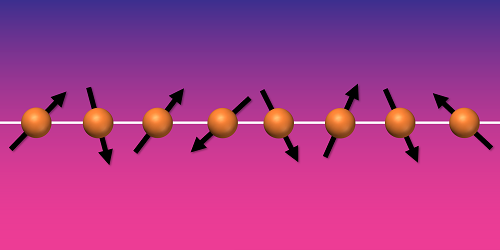Hidden Topology of Spin Chains
A fundamental model in quantum magnetism is the so-called spin-1 antiferromagnetic Heisenberg chain. This model describes a one-dimensional string of spin-1 particles that are coupled to each other through an interaction that favors neighboring spins being antiparallel. Despite its idealized nature, the model can be accurately realized in actual materials, making it an important test bed in condensed-matter physics. In the early 1980s, theorist Duncan Haldane proposed that such a system’s ground state is unique and gapped—that is, separated from the system’s excited states by an energy barrier. Now Hal Tasaki at Gakushuin University in Japan has rigorously proven that, if Haldane’s argument is correct, the ground state has nontrivial topology [1]. This finding indicates that the system exhibits exotic phenomena such as topologically protected edge states and topological phase transitions, which have potential applications in various quantum technologies.
In general, a quantum many-body system can have one of three types of ground state: one that is unique, gapped, and topologically trivial; one that is unique, gapped, and topologically nontrivial; or one that is either nonunique or gapless. In a step-by-step mathematical proof, Tasaki ruled out the first possibility for the spin-1 antiferromagnetic Heisenberg chain by demonstrating that the system’s ground state cannot be simultaneously unique, gapped, and topologically trivial. The researcher says that the remaining challenge is to prove that the ground state is unique and gapped. He encourages scientists to develop novel mathematical techniques that would accomplish this task, probably with the aid of a computer.
–Ryan Wilkinson
Ryan Wilkinson is a Corresponding Editor for Physics Magazine based in Durham, UK.
References
- H. Tasaki, “Ground state of the S = 1 antiferromagnetic Heisenberg chain is topologically nontrivial if gapped,” Phys. Rev. Lett. 134, 076602 (2025).




